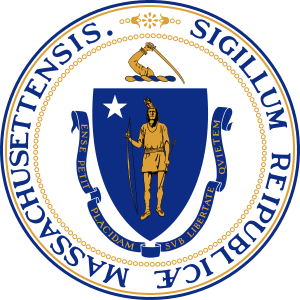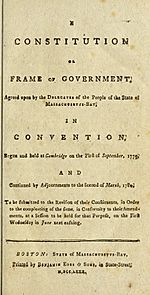Constitution of Massachusetts facts for kids
Quick facts for kids Constitution of the Commonwealth of Massachusetts |
|
|---|---|

|
|
| Jurisdiction | Commonwealth of Massachusetts |
| Subordinate to | Constitution of the United States |
| Created | October 30, 1779 |
| Presented | June 15, 1780 |
| Ratified | October 25, 1780 |
| System | Presidential Republic |
| Branches | 3 |
| Chambers | Massachusetts General Court: Massachusetts Senate Massachusetts House of Representatives |
| Executive | Governor of Massachusetts |
| Judiciary | Supreme, Appeals, Trial |
| First legislature | October 25, 1780 |
| First executive | October 25, 1780 |
| First court | October 25, 1780 |
| Amendments | 120 |
| Commissioned by | Massachusetts Provincial Congress |
| Author(s) | John Adams |
| Supersedes | Massachusetts Charter |
The Constitution of the Commonwealth of Massachusetts is the main rulebook for the government of Commonwealth of Massachusetts. Massachusetts is one of the 50 states that make up the United States of America.
John Adams, who later became the second U.S. President, was the main writer of this important document. He was part of the Massachusetts Constitutional Convention in 1779. People voted to approve the constitution on June 15, 1780. It officially started on October 25, 1780. This makes it one of the oldest working written constitutions in the world that is still used today. Only parts of the constitutions of San Marino and Vermont are older.
The Massachusetts Constitution was also the first one written by a special meeting called just for that purpose. Before this, laws were usually made by regular lawmakers. This constitution was written after the first constitutions of the other original states. Instead of just being a list of rules, it was organized into chapters and sections. This structure was later used as a model for the U.S. Constitution, which was written seven years later. It also helped shape many other state constitutions.
The Massachusetts Constitution has four main parts: an introduction (called a preamble), a list of rights, a description of how the government works, and a list of changes (amendments). It has been changed 120 times, with the most recent change happening in 2000.
Contents
History of the Massachusetts Constitution
In 1775, John Adams believed that each state should hold a special meeting to write its own constitution. He thought these constitutions should then be voted on by the people. He told the Continental Congress that people should create their own governments. He said this should be done by special meetings of representatives chosen by the people. Adams believed that the people were the source of all power.
The lawmakers in Massachusetts, called the Massachusetts General Court, tried to write a constitution first. They sent their version to the voters in 1778, but it was rejected. This first version did not separate the government's powers. It also did not include a clear list of individual rights.
So, the General Court then set up an election for delegates from each town. These delegates would meet to write a new constitution. This new document would then be put to a popular vote. It was agreed that two-thirds of the voters would need to approve it for it to pass. The special meeting to write the constitution took place in Cambridge in September 1779.
The meeting lasted from September 1 to October 30, 1779. There were 312 members. They chose a smaller committee of thirty members to prepare the new constitution and a declaration of rights. This committee asked John Adams to write the declaration of rights. A smaller group of three, including James Bowdoin, Samuel Adams, and John Adams, was chosen to write the constitution. They decided that John Adams would write it all by himself. He later joked that he was a "sub-sub committee of one."
John Adams's first draft of the declaration of rights said: "All men are born equally free and independent..." This was later changed to: "All men are born free and equal..." This change was made before the constitutional meeting approved it. John Adams also insisted that the state be called a "commonwealth."
Male voters who were 21 years or older approved the constitution and declaration of rights. This happened at the convention on June 15, 1780. The constitution officially began on October 25, 1780.
Preamble: The Constitution's Introduction
The preamble is the introduction to the Massachusetts Constitution. It explains the reasons for creating the government. This part was used as a guide when the U.S. Constitution was written a few years later. Some phrases from the Massachusetts preamble even appear in the U.S. Constitution.
The preamble says that the government's purpose is to keep the community safe. It should protect individuals and help them enjoy their natural rights and a good life. If the government fails to do this, the people have the right to change it. They can take steps needed for their safety, success, and happiness.
It also states that the community is formed when people willingly join together. This is like a promise where everyone agrees to follow certain laws for the good of all. So, when creating a government, people must make sure laws are fair. They must also ensure laws are understood and carried out properly. This way, everyone can always feel safe and secure under the law.
The people of Massachusetts thanked a "great Legislator of the universe" for this chance. They wanted to create a new civil government for themselves and future generations. They asked for guidance in this important task. Then, they agreed to establish the Declaration of Rights and Frame of Government. These parts together form the Constitution of the Commonwealth of Massachusetts.
Declaration of Rights: Your Basic Freedoms
"Part the First: A Declaration of the Rights of the Inhabitants of the Commonwealth of Massachusetts" has thirty articles. The first article is very important.
It says:
Article I. All men are born free and equal and have certain natural, essential, and unalienable rights; among which may be reckoned the right of enjoying and defending their lives and liberties; that of acquiring, possessing, and protecting property; in fine, of seeking and obtaining their safety and happiness.
This article was key in a famous court case in 1781. A Black woman named Elizabeth Freeman (also known as "Bett") was enslaved by Colonel John Ashley. She sued for her freedom based on this article. The jury agreed that slavery did not fit with the Massachusetts Constitution. They granted Freeman her freedom.
A few years later, another enslaved Black man named Quock Walker also sued for his freedom. The jury ruled in his favor and he gained his freedom. These cases showed that slavery had no legal protection in Massachusetts. This effectively ended slavery in the Commonwealth.
In 1976, Article I was updated. The word "men" was changed to "people." An extra sentence was added: "Equality under the law shall not be denied or abridged because of sex, race, color, creed or national origin." This change made sure that everyone had equal rights, no matter their gender, race, or background.
The original 1780 Constitution also talked about religion. Article II said it was a right and duty for all people to worship a "Supreme Being." It also said no one should be harmed for their religious beliefs. This was true as long as they did not disturb public peace.
Article III connected the happiness of people and good government to religion and morality. This article allowed towns to use local tax money to support a Protestant church. The town would vote on which church to support.
For many years, these town-supported churches had special legal rights. By 1824, full religious freedom was granted in Massachusetts. This meant people could worship as they chose. This part of the constitution was later changed in 1834.
Frame of Government: How Massachusetts is Run
Part II, Chapter I, Section I of the constitution states the official name of Massachusetts.
It says:
The people, inhabiting the territory formerly called the Province of Massachusetts Bay, do hereby solemnly and mutually agree with each other, to form themselves into a free, sovereign, and independent body politic, or state by the name of THE COMMONWEALTH OF MASSACHUSETTS.
The first three articles in this section set up the three main parts of the government. These are the executive (Governor), the legislative (lawmakers), and the judicial (courts). This system was unique at the time. It was designed to keep the powers separate. The people who wrote the constitution wanted to prevent any one part of the government from becoming too powerful.
- Article I says the lawmaking part will have two branches. These are the Senate and the House of Representatives. Each branch can say "no" to the other.
- Article II states that no bill can become a law until the Governor reviews it.
- Article III gives the General Court the power to create courts. These courts would operate in the name of the Commonwealth.
Removing Officials: Impeachment
Massachusetts has a way to remove government officials who do wrong. This is called impeachment. The Legislature can do this. They can also prevent convicted officials from ever holding a public job again in Massachusetts.
Articles of Amendment: Changes to the Constitution
There are 120 Articles of Amendment that have been added to the Massachusetts Constitution. These are like updates or changes to the original document. The most recent change happened in 2000. It prevents people in prison for serious crimes from voting.
The process for changing the constitution is set by the 48th Article of Amendment. This process involves action by the state legislature and then a public vote.
For a change to be put before voters, a special meeting is needed. This is called a constitutional convention. It is a joint meeting of both houses of the legislature. This meeting must happen in two legislative sessions in a row.
If a lawmaker suggests the change, it needs approval from 50% of the members. If citizens propose the change with a petition, it needs approval from 25% of the members. The number of votes needed is based on the total number of seats in the convention.
Citizens who want to propose an amendment need to collect signatures. The number of signatures must be 3% of the total votes cast for all candidates for governor in the last state election.
Constitutional Conventions: Special Meetings
Massachusetts has held four special meetings of elected delegates. These are different from regular legislative sessions.
- The Massachusetts Constitutional Convention of 1779–1780 wrote the original constitution.
- The Massachusetts Constitutional Convention of 1820–1821 suggested several changes. This led to the first nine amendments being added.
- The Massachusetts Constitutional Convention of 1853 also proposed changes.
- The Massachusetts Constitutional Convention of 1917–1918 was the last one.



